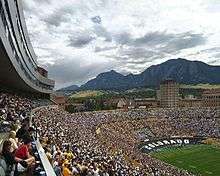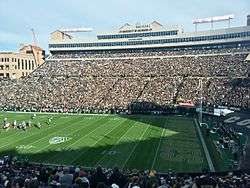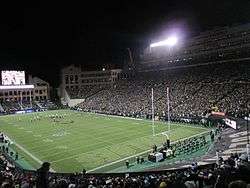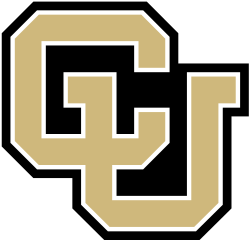Folsom Field
 View to southwest & Flatirons, 2008 | |
| Former names |
Colorado Stadium (1924–1944) |
|---|---|
| Location |
2400 Colorado Avenue Boulder, Colorado |
| Coordinates | 40°00′32″N 105°16′01″W / 40.009°N 105.267°WCoordinates: 40°00′32″N 105°16′01″W / 40.009°N 105.267°W |
| Owner | University of Colorado |
| Operator | University of Colorado |
| Capacity |
26,000 (1924–1955) 45,000 (1956–1966) 50,516 (1967–1975) 52,005 (1976–1978) 51,463 (1979–1990) 51,748 (1991–1995) 51,808 (1996–1998) 51,655 (1999–2000) 50,942 (2001–2002) 53,750 (2003–2009) 53,613 (2010–2013) 50,183 (2014–present)[1] |
| Record attendance | 54,972 |
| Surface |
Grass (1924–70, 1999–present) AstroTurf (1971–98) |
| Construction | |
| Broke ground | January 14, 1924[1] |
| Opened |
October 11, 1924 94 years ago |
| Renovated | 1968, 1976, 2003 |
| Expanded | 1956, 1967, 2003 |
| Construction cost | $65,000 (1924) |
| Architect |
Waldo E. Brockway[2] Sink Combs Dethlefs (renovations) |
| Tenants | |
|
Colorado Buffaloes (NCAA) (1924–present) | |

Field
Folsom Field is an outdoor football stadium in the western United States, located on the campus of the University of Colorado in Boulder. It is the home field of the Colorado Buffaloes of the Pac-12 Conference.
Opened 94 years ago in 1924, the horseshoe-shaped stadium runs in the traditional north-south configuration, opening to the north. The CU athletic administration center, named after 1950s head coach Dal Ward, is located at the north end.[3]
The playing field returned to natural grass in 1999 and sits at an elevation of 5,360 feet (1,630 m), more than a mile above sea level.[4] Folsom Field is the third highest stadium in major college football, behind only Wyoming and Air Force of the Mountain West Conference.
History
Gamble Field was the home of Colorado football for two decades, through 1924 mid-season. Opened as Colorado Stadium, Folsom Field has been the home of Colorado Buffaloes football since. Through the 2016 season, the Buffs have a home record of 308–169–14, a winning percentage of .642.
Colorado Stadium was renamed Folsom Field in 1944, following the death of coach Fred Folsom. He coached the Buffs from 1895 to 1902 and 1908 to 1915, compiling a 78–24–2 (.760) overall record.
In 2008, Folsom Field became the first "zero-waste" stadium in the NCAA by instituting a rigorous recycling and composting program.
Expansions and renovations
When opened in 1924, the horseshoe-shaped stadium had a capacity of 26,000. A major expansion in 1956 raised the height of the stadium and increased its capacity to 45,000. In 1967, 6,000 more seats were added with the removal of the running track; the track and field team relocated to Potts Field on the East Campus.[5][6]
A huge, six-level press box was added in 1968 to the top of the west side grandstand, directly in front of Balch Fieldhouse, the former home of the basketball team. Renovations continued in 1976 when the old, rickety wooden bleachers were replaced with aluminum ones, raising the capacity to 52,005.
In 2003, suites and club seating were added to the east side of the stadium, raising the capacity to 53,750.[7] Since the 2003 renovation 137 seats with obstructed views have been removed lowering the seating capacity to 53,613.[8]
In 2014, construction for a further expansion has started. This expansion includes a new indoor practice facility, a high performance sports center, as well as extra seating on the northeast corner of the stadium.[9][10]
Playing surface
From 1924 through 1970, the playing surface at Folsom Field was natural grass. In the summer of 1971, AstroTurf was installed and the first game played on the new surface was against Wyoming on September 18. The 1971 Buffs finished third in the AP Poll behind Nebraska and Oklahoma, for a sweep of the top three spots by the Big Eight Conference.[11] The synthetic turf was replaced in 1978 and again in 1989, with "Astroturf-8."[12] After 28 years of AstroTurf, Folsom Field returned to natural grass in the spring of 1999.[13] The project, which included bio-thermal heating, drainage, and a sub-air system, cost $1.2 million.
Other uses
Concerts
The Rolling Stones October 3 / 4 1981 The stadium played host to a concert, later released on DVD, by the Dave Matthews Band on July 11, 2001. More recently, in keeping with the decision to bring back live music to Folsom Field, the stadium hosted Dead & Co. for two-night stands during their 2016 and 2017 summer tours.
| Date | Artist | Opening act(s) | Tour / Concert name | Attendance | Revenue | Notes |
|---|---|---|---|---|---|---|
| May 26, 1993 | Paul McCartney | — | The New World Tour | 37,245 / 39,137 | $1,210,463 | |
| July 11, 2001 | Dave Matthews Band | Angelique Kidjo Wyclef Jean | Summer 2001 Tour | 43,041 / 43,041 | $2,130,593 | This show was recorded for the album and DVD entitled, Live at Folsom Field, Boulder, Colorado.[14] |
| July 2, 2016 | Dead & Co. | — | Dead & Company Summer Tour 2016 | 49,166 / 85,582 | $4,179,233 | [15] |
| July 3, 2016 | ||||||
| June 9, 2017 | Dead & Company Summer Tour 2017 | 55,882 / 86,982 | $4,365,860 | |||
| June 10, 2017 |
In popular culture
The south end zone was featured in the opening and closing credits of the late 1970s television show Mork and Mindy, which was set in Boulder.
Other events
Folsom Field is also used as the finish line for the Bolder Boulder, a popular 10K run.
The first Promise Keepers stadium conference was held at Folsom in June 1992.
Attendance records
The largest crowd for a CU football game at Folsom Field was 54,972 in 2005, against in-state rival Colorado State on September 3, in which Colorado Buffaloes won thanks to a 47 yard field goal kicked by Mason Crosby with four seconds remaining [16]. This early-season, non-conference rivalry game, the Rocky Mountain Showdown, is more often played in neutral Denver at Mile High Stadium and it successor Sports Authority Field at Mile High.[1]
The largest crowd ever at Folsom Field was in 1977 for a rock concert, one of the popular Colorado Sun Day concert series. The attendance on May 1 was an estimated 61,500 (exceeding the seating capacity by about 9,000) for a show featuring Fleetwood Mac, Bob Seger, Firefall, and John Sebastian.


| Season | Coach | Games | Sellouts | W-L-T | Attendance | Average |
|---|---|---|---|---|---|---|
| 1937 | Oakes | 6 | 6-0-0 | 46,826 | 7,804 | |
| 1942 | Yeager | 4 | 4-0-0 | 15,796 | 3,949 | |
| 1946 | Yeager | 5 | 4-0-1 | 53,000 | 10,600 | |
| 1947 | Yeager | 4 | 2-2-0 | 54,000 | 13,500 | |
| 1948 | Ward | 5 | 3-2-0 | 79,479 | 15,896 | |
| 1949 | Ward | 5 | 2-3-0 | 98,776 | 19,755 | |
| 1950 | Ward | 5 | 4-1-0 | 97,748 | 19,550 | |
| 1951 | Ward | 5 | 5-0-0 | 107,121 | 21,424 | |
| 1952 | Ward | 5 | 2 | 3-0-2 | 123,481 | 24,696 |
| 1953 | Ward | 5 | 3-2-0 | 113,640 | 22,728 | |
| 1954 | Ward | 5 | 2 | 3-2-0 | 129,700 | 25,940 |
| 1955 | Ward | 5 | 1 | 4-1-0 | 113,500 | 22,700 |
| 1956 | Ward | 5 | 2 | 3-2-0 | 175,000 | 35,000 |
| 1957 | Ward | 5 | 3-2-0 | 152,500 | 30,500 | |
| 1958 | Ward | 5 | 1 | 2-3-0 | 187,500 | 37,500 |
| 1959 | Grandelius | 6 | 3-3-0 | 177,903 | 29,651 | |
| 1960 | Grandelius | 5 | 1 | 4-1-0 | 185,653 | 37,131 |
| 1961 | Grandelius | 6 | 1 | 5-1-0 | 199,987 | 33,331 |
| 1962 | Davis | 4 | 2-2-0 | 116,000 | 29,000 | |
| 1963 | Crowder | 5 | 1-4-0 | 135,000 | 27,000 | |
| 1964 | Crowder | 5 | 1-4-0 | 140,600 | 28,120 | |
| 1965 | Crowder | 5 | 3-1-1 | 129,700 | 25,940 | |
| 1966 | Crowder | 5 | 1 | 3-2-0 | 196,188 | 39,238 |
| 1967 | Crowder | 5 | 4-1-0 | 196,817 | 39,363 | |
| 1968 | Crowder | 5 | 1 | 3-2-0 | 215,574 | 43,115 |
| 1969 | Crowder | 5 | 5-0-0 | 175,104 | 35,021 | |
| 1970 | Crowder | 5 | 1 | 3-2-0 | 219,521 | 43,904 |
| 1971 | Crowder | 5 | 5-0-0 | 220,171 | 44,034 | |
| 1972 | Crowder | 6 | 3 | 5-1-0 | 307,044 | 51,174 |
| 1973 | Crowder | 5 | 3-2-0 | 246,521 | 49,304 | |
| 1974 | Mallory | 5 | 2 | 3-2-0 | 253,762 | 50,752 |
| 1975 | Mallory | 6 | 6-0-0 | 281,199 | 46,867 | |
| 1976 | Mallory | 6 | 2 | 5-1-0 | 300,191 | 50,032 |
| 1977 | Mallory | 6 | 2 | 5-1-0 | 293,483 | 48,914 |
| 1978 | Mallory | 8 | 2 | 5-3-0 | 383,048 | 47,881 |
| 1979 | Fairbanks | 6 | 1-5-0 | 265,956 | 44,326 | |
| 1980 | Fairbanks | 6 | 1 | 1-5-0 | 245,868 | 40,978 |
| 1981 | Fairbanks | 6 | 3-3-0 | 209,224 | 34,871 | |
| 1982 | McCartney | 7 | 1 | 1-6-0 | 251,909 | 41,985 |
| 1983 | McCartney | 6 | 1 | 3-3-0 | 237,674 | 39,612 |
| 1984 | McCartney | 6 | 1 | 1-5-0 | 235,670 | 39,278 |
| 1985 | McCartney | 6 | 4-2-0 | 220,734 | 36,789 | |
| 1986 | McCartney | 6 | 2 | 3-3-0 | 269,546 | 44,924 |
| 1987 | McCartney | 6 | 1 | 4-2-0 | 268,711 | 44,785 |
| 1988 | McCartney | 6 | 4-2-0 | 235,142 | 39,190 | |
| 1989 | McCartney | 6 | 2 | 6-0-0 | 293,726 | 48,954 |
| 1990 | McCartney | 6 | 4 | 6-0-0 | 310,374 | 51,729 |
| 1991 | McCartney | 6 | 4 | 4-1-1 | 311,458 | 51,910 |
| 1992 | McCartney | 6 | 4 | 5-0-1 | 309,900 | 51,650 |
| 1993 | McCartney | 6 | 5 | 4-2-0 | 311,360 | 51,893 |
| 1994 | McCartney | 6 | 3 | 6-0-0 | 304,897 | 50,816 |
| 1995 | Neuheisel | 6 | 4 | 4-2-0 | 312,958 | 52,160 |
| 1996 | Neuheisel | 6 | 4 | 5–1 | 312,586 | 52,098 |
| 1997 | Neuheisel | 6 | 2 | 3–3 | 309,947 | 51,658 |
| 1998 | Neuheisel | 6 | 5–1 | 284,512 | 47,419 | |
| 1999 | Barnett | 5 | 1 | 4–1 | 239,313 | 47,863 |
| 2000 | Barnett | 5 | 1–4 | 249,950 | 49,990 | |
| 2001 | Barnett | 6 | 1 | 5–1 | 284,848 | 47,475 |
| 2002 | Barnett | 6 | 2 | 5–1 | 295,286 | 49,214 |
| 2003 | Barnett | 6 | 2 | 3–3 | 302,588 | 50,431 |
| 2004 | Barnett | 6 | 1 | 4–2 | 287,368 | 47,895 |
| 2005 | Barnett | 6 | 2 | 5–1 | 302,452 | 50,409 |
| 2006 | Hawkins | 6 | 2–4 | 276,286 | 46,048 | |
| 2007 | Hawkins | 6 | 3–3 | 303,051 | 50,509 | |
| 2008 | Hawkins | 6 | 1 | 4–2 | 296,858 | 49,476 |
| 2009 | Hawkins | 6 | 3–3 | 300,527 | 50,088 | |
| 2010 | Hawkins | 6 | 4–2 | 281,182 | 46,864 | |
| 2011 | Embree | 5 | 1–4 | 251,777 | 50,355 | |
| 2012 | Embree | 6 | 0–6 | 273,235 | 45,539 | |
| 2013 | MacIntyre | 6 | 3–3 | 230,773 | 38,462 | |
| 2014 | MacIntyre | 6 | 1–5 | 226,670 | 37,778 | |
| 2015 | MacIntyre | 6 | 2–4 | 236,331 | 39,389 | |
| 2016 | MacIntyre | 6 | 1 | 6–0 | 279,652 | 46,609 |
| 2017 | MacIntyre | 6 | 3–3 | 282,335 | 47,056 | |
Gallery
 The Colorado Buffaloes play at Colorado Stadium sometime in the 1920s.
The Colorado Buffaloes play at Colorado Stadium sometime in the 1920s. Folsom Field between 1933 and 1950. The team is practicing in the North end of the field.
Folsom Field between 1933 and 1950. The team is practicing in the North end of the field. Folsom Field 135th commencement on June 9, 1967. 1,836 degrees were awarded.
Folsom Field 135th commencement on June 9, 1967. 1,836 degrees were awarded. Club and box seats built prior to 2003 season on July 13, 2006
Club and box seats built prior to 2003 season on July 13, 2006 Facade built prior to 2003 season on July 13, 2006
Facade built prior to 2003 season on July 13, 2006 View from the club level seats before the football Spring Game on April 14, 2007
View from the club level seats before the football Spring Game on April 14, 2007 View to the southwest of the Flatirons in 2016
View to the southwest of the Flatirons in 2016 A view of the north side of the stadium in 2016.
A view of the north side of the stadium in 2016. New video boards were added before the 2012 season.
New video boards were added before the 2012 season. Folsom Field's east side as it looked in 2016 after the addition of the Champions Center.
Folsom Field's east side as it looked in 2016 after the addition of the Champions Center.
See also
References
- 1 2 3 "Folsom Field Home". University of Colorado Department of Athletics. Retrieved March 6, 2007.
- ↑ "Historic Building Inventory Record" (PDF). Colorado Historical Society. Retrieved September 19, 2013.
- ↑ Colorado.edu - CU campus map
- ↑ Color aerial view (& topographic map) of CU campus from USGS via Microsoft Research Maps
- ↑ "Folsom track goes". Reading Eagle. (Pennsylvania). Associated Press. June 24, 1966. p. 26.
- ↑ "New track ready for Colorado meet". Lawrence Journal-World. (Kansas). Associated Press. April 28, 1967. p. 15.
- ↑ "Folsom Field History". University of Colorado Department of Athletics. Retrieved October 3, 2012.
- ↑ "Game 2–California" (PDF). University of Colorado Department of Athletics. September 7, 2010. Archived from the original (PDF) on March 16, 2012. Retrieved October 3, 2012.
- ↑ Whitehair, Stuart (January 2, 2012). "Colorado Daily – January". CU at the Game. Retrieved October 3, 2012.
- ↑ http://www.ralphiereport.com/videos/2014/4/14/5611642/fly-through-upcoming-colorado-buffaloes-facilities-upgrades
- ↑ College FB Data Warehouse 1971 Final AP poll
- ↑ CU Buffs.com Folsom Field playing surface
- ↑ "Colorado stadium changing to grass". Victoria Advocate. (Texas). Associated Press. December 4, 1998. p. 2B.
- ↑ "DMBAlmanac entry for 7.11.01". Retrieved 2009-07-12.
- ↑ http://theknow.denverpost.com/2017/06/11/dead-company-boulder-folsom-field-2017/147558/
- ↑ http://www.cuatthegame.com/2005/colorado-state-2/
